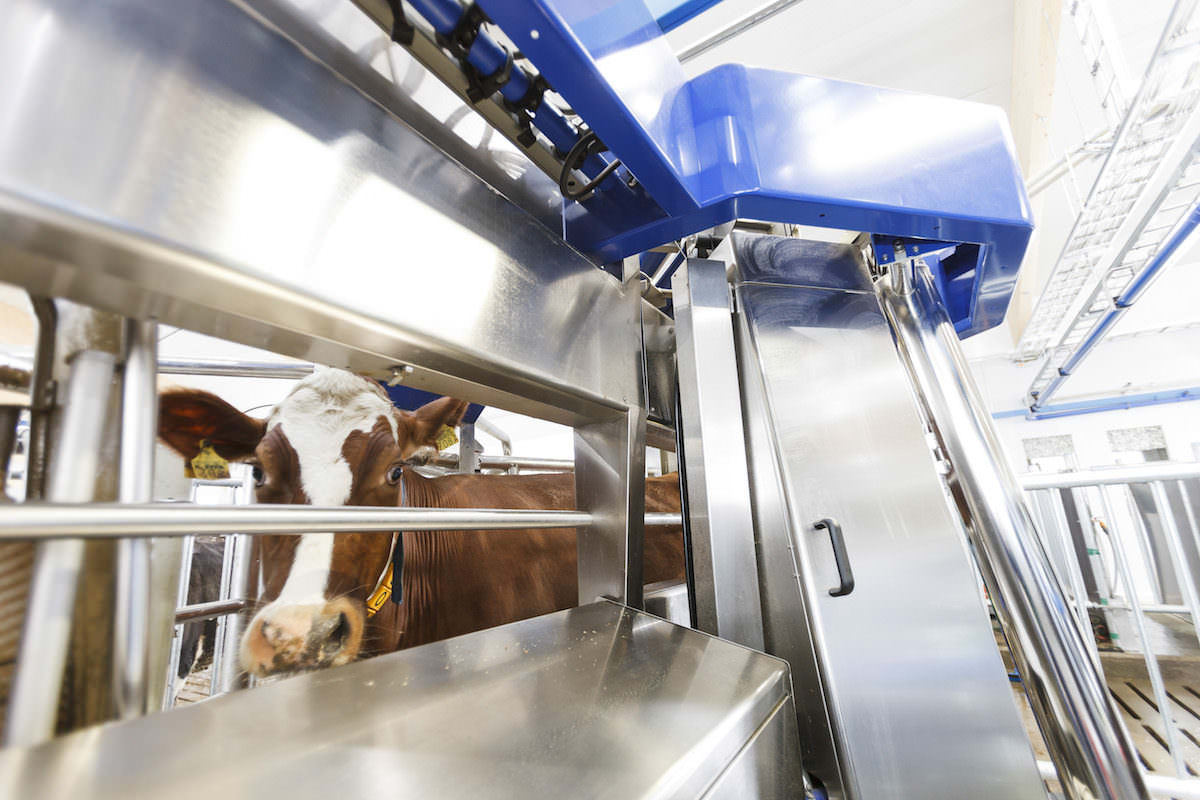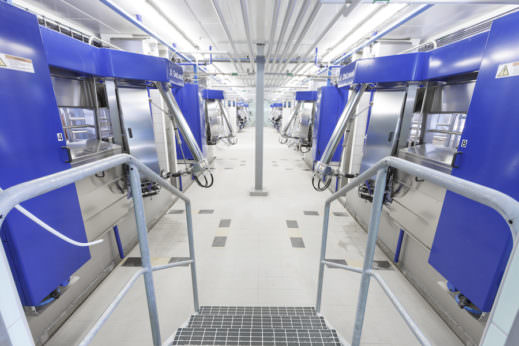Rise of the (Cow Milking) Robots
DeLaval International, a large Swedish producer of dairy and other farming equipment, is installing 24 robotic voluntary - meaning the cows approach the stations on their own - mil...
Rise of the (Cow Milking) Robots
DeLaval International, a large Swedish producer of dairy and other farming equipment, is installing 24 robotic voluntary - meaning the cows approach the stations on their own - mil...

DeLaval International, a large Swedish producer of dairy and other farming equipment, is installing 24 robotic voluntary – meaning the cows approach the stations on their own – milking machines at TDI Farms LLC of Westphalia that will be able to milk 1,500 cows. The new system will be operational sometime next year (no firm date has been set yet), according to Muhieddine Labban, solution manager of automatic milking systems at DeLaval.
The farm is owned by the Trierweiler family. They decided to transition to a robotic milking system after seeing improved longevity and lower cull rates of cows in dairy farms using these systems.
“For the last few years, my family has been discussing the farm’s next steps. Ultimately, the conversations kept coming back to robotics as we felt it was the best fit,” said Bryant Trierweiler, one of the owners, in a press statement.
Here’s how the Voluntary Milking System machine works: the cows are free to come to the machine to be milked as they please, drawn by the feed that is dispensed during milking. Because the animals are creatures of habit, they learn this routine within a few days, says Labban in an email. The system cleans, pre-milks, dries and stimulates each teat individually using water, compressed air and a vacuum. After this preparation stage, the cows are milked via a robotic attachment that scans their underside to detect where the teats are located and checks the milk flow before releasing the suction cup at the end of the milking session.

According to DeLaval, the VMS is better for cows than traditional milking systems since it has an open structure that allows the cow to see her surroundings and to stand in a comfortable position without human management, which can be stressful for the animals. The VMS also monitors udder health and can detect potentially life-threatening mammary gland infections.
Now to the question that always comes up when we talk robots: what about the farm workers who previously did the milking? The Trierweilers say they plan to develop their employees’ skills in other directions in the company. “We have a great core of employees and prefer to develop their talents as opposed to adding more labor,” said Bryant Treirweiler.
“Robotic milking technology allows for a better trained and more flexible workforce,” – Muhieddine Labban
Labban says the “human element remains a critical factor” and that without a “motivated, competent and committed workforce, it’s impossible to build a successful dairy business.” Robotic milking technology allows for a better trained and more flexible workforce, he says.
“Workers can now make better use of their time by handling chores and tasks that are critical to a well-managed dairy operation. The VMS increases efficiency, providing the dairy producer with the opportunity to hire fewer, but higher-caliber trained and qualified people,” he tells Modern Farmer in an email.
Labban wouldn’t give specifics on the cost of the VMS system, only saying that the price is “dependent on several factors.”
DeLaval is also involved in the creation in one of the largest robotic milking facilities in the world, which is being constructed in Los Angeles, Chile. El Fundo Risquillo farm will have a total of 64 machines milking 4,500 cows, according to DeLaval. It’s slated to be on line early next year.
The VMS isn’t the only robotic milking system out there. GEA Farm Technologies, based in Germany, has the DairyProQ, a robotic rotary system that is in use on two dairy farms in Germany and two in Canada.
Here’s a video of the dairy farm in British Columbia using the DairyProQ.
Follow us
This work is licensed under a Creative Commons Attribution-NoDerivatives 4.0 International License.
Want to republish a Modern Farmer story?
We are happy for Modern Farmer stories to be shared, and encourage you to republish our articles for your audience. When doing so, we ask that you follow these guidelines:
Please credit us and our writers
For the author byline, please use “Author Name, Modern Farmer.” At the top of our stories, if on the web, please include this text and link: “This story was originally published by Modern Farmer.”
Please make sure to include a link back to either our home page or the article URL.
At the bottom of the story, please include the following text:
“Modern Farmer is a nonprofit initiative dedicated to raising awareness and catalyzing action at the intersection of food, agriculture, and society. Read more at <link>Modern Farmer</link>.”
Use our widget
We’d like to be able to track our stories, so we ask that if you republish our content, you do so using our widget (located on the left hand side of the article). The HTML code has a built-in tracker that tells us the data and domain where the story was published, as well as view counts.
Check the image requirements
It’s your responsibility to confirm you're licensed to republish images in our articles. Some images, such as those from commercial providers, don't allow their images to be republished without permission or payment. Copyright terms are generally listed in the image caption and attribution. You are welcome to omit our images or substitute with your own. Charts and interactive graphics follow the same rules.
Don’t change too much. Or, ask us first.
Articles must be republished in their entirety. It’s okay to change references to time (“today” to “yesterday”) or location (“Iowa City, IA” to “here”). But please keep everything else the same.
If you feel strongly that a more material edit needs to be made, get in touch with us at [email protected]. We’re happy to discuss it with the original author, but we must have prior approval for changes before publication.
Special cases
Extracts. You may run the first few lines or paragraphs of the article and then say: “Read the full article at Modern Farmer” with a link back to the original article.
Quotes. You may quote authors provided you include a link back to the article URL.
Translations. These require writer approval. To inquire about translation of a Modern Farmer article, contact us at [email protected]
Signed consent / copyright release forms. These are not required, provided you are following these guidelines.
Print. Articles can be republished in print under these same rules, with the exception that you do not need to include the links.
Tag us
When sharing the story on social media, please tag us using the following: - Twitter (@ModFarm) - Facebook (@ModernFarmerMedia) - Instagram (@modfarm)
Use our content respectfully
Modern Farmer is a nonprofit and as such we share our content for free and in good faith in order to reach new audiences. Respectfully,
No selling ads against our stories. It’s okay to put our stories on pages with ads.
Don’t republish our material wholesale, or automatically; you need to select stories to be republished individually.
You have no rights to sell, license, syndicate, or otherwise represent yourself as the authorized owner of our material to any third parties. This means that you cannot actively publish or submit our work for syndication to third party platforms or apps like Apple News or Google News. We understand that publishers cannot fully control when certain third parties automatically summarize or crawl content from publishers’ own sites.
Keep in touch
We want to hear from you if you love Modern Farmer content, have a collaboration idea, or anything else to share. As a nonprofit outlet, we work in service of our community and are always open to comments, feedback, and ideas. Contact us at [email protected].by Andrew Amelinckx, Modern Farmer
December 12, 2016
Modern Farmer Weekly
Solutions Hub
Innovations, ideas and inspiration. Actionable solutions for a resilient food system.
ExploreExplore other topics
Share With Us
We want to hear from Modern Farmer readers who have thoughtful commentary, actionable solutions, or helpful ideas to share.
SubmitNecessary cookies are absolutely essential for the website to function properly. This category only includes cookies that ensures basic functionalities and security features of the website. These cookies do not store any personal information.
Any cookies that may not be particularly necessary for the website to function and are used specifically to collect user personal data via analytics, ads, other embedded contents are termed as non-necessary cookies.
Knowing about cows and how robots milk them is really a good knowledge, owing for quality milk and the safety of cows. Expecting this kind of quality blogs in the future, listing out the factors of robotic voluntary milking systems!
we have 32 AMS farms in Kaluga region of Russia and very glad with them